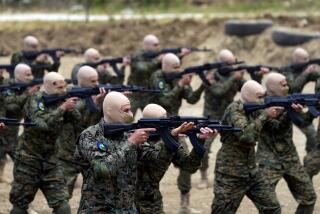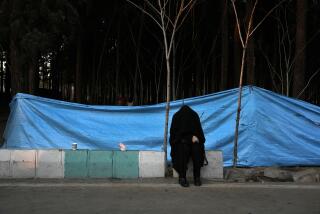Paris violence may portend upmanship between Al Qaeda group, Islamic State
Reporting From Washington â The remote Persian Gulf nation of Yemen has been frequently mentioned this week after the attack on a magazine office in Paris, especially after a spokesman for Al Qaedaâs affiliate there appeared Friday to claim responsibility for the attack as ârevenge for the honorâ of Islamâs prophet Muhammad.
U.S. and European authorities are trying now to establish whether the group had a role in planning the attack. If it did, that could suggest that Al Qaeda in the Arabian Peninsula is trying to regain momentum in what could shape up as a grisly battle of one-upmanship between rival terrorist groups.
The evidence is still murky.
Said Kouachi, who authorities say was one of the gunmen in the deadly attack Wednesday on the satirical magazine Charlie Hebdo, is believed to have traveled to Yemen in 2011 to train with the group.
At the time, the militant organization was a magnet for Westerners wanting to join Al Qaeda. The Yemen cell was responsible for both the failed attempt to blow up a jetliner bound for Detroit on Christmas Day 2009, and a disrupted plot a year later to set off explosives in printer cartridges shipped to Chicago.
Kouachi appears to have returned to France in mid-2011, before Anwar Awlaki, the American-born cleric who directed the groupâs outreach to Europeans and Americans, was killed by a U.S. airstrike.
U.S. intelligence officials say Kouachi may have lost contact with his handler in the Yemen affiliate after Awlaki was killed and that the death may have disrupted plans for Kouachi to launch an attack earlier.
That could explain why Kouachi, 34, kept a low profile for years before the attack in Paris, one official said on condition of anonymity because he was discussing internal assessments.
The U.S. highly suspects there was some direction from Al Qaeda in the Arabian Peninsula in the magazine office attack, if not directly then by encouraging it, perhaps through email, another official said.
That leaves open the possibility that Kouachi drew on his training to plan the attack with his brother Cherif, 32, also suspected in the magazine attack, or with a close circle of associates in France.
The brothers were believed to have been killed Friday in a police raid.
Such a homegrown plot would not have required ongoing communication with leaders in Yemen and would have made the plot harder to detect.
âThey knew how to wield guns. They had done military maneuvers, and they got away,â said a person familiar with the investigation, speaking on condition of anonymity because the case is still fluid.
Al Qaedaâs affiliate in Yemen gained influence and followers more than five years ago, as the CIA stepped up its targeted drone strikes against Al Qaedaâs leadership in the border regions of Pakistan and key operatives moved to Somalia and Yemen. By 2010, U.S. intelligence officials saw the Yemen group as a more dangerous threat to the U.S. than Al Qaedaâs core leadership.
Dozens of Americans charged with planning terrorist plots over the last five years have said they were influenced by the Internet sermons of Awlaki, including Dzhokhar Tsarnaev, charged with placing explosives near the 2013 Boston marathon finish line that killed three and wounded hundreds.
But in the last year, Al Qaeda in the Arabian Peninsula has been eclipsed in the headlines by another militant organization, Islamic State, which has blitzed across northern Iraq and taken over large swaths of that country and Syria.
âThere is this active rivalry between the two groups,â said David Gomez, a retired FBI profiler and counter-terrorism expert. âThey are competing for the leadership of the jihadist movement.â
The two groups vied for the loyalty of foreign fighters who streamed into Syria to join the nearly four-year-old civil war there.
In 2013, Al Qaeda leadership sent senior operatives from Yemen and other conflict zones to Syria to recruit Western passport holders from among the fighters, with the aim of launching attacks in Europe, U.S. intelligence officials have said.
U.S. intelligence officials called the unit of about 50 operatives the Khorasan Group. In September, the U.S. targeted Khorasan leaders during the first U.S. airstrikes in Syria, which were part of the campaign to tame Islamic State.
Though Islamic State has repeatedly declared that its chief intent is to establish a caliphate in the Middle East, Al Qaedaâs immediate goal remains to attack the West, and its desire to do so has not diminished, U.S. officials have warned.
Al Qaeda in the Arabian Peninsula has encouraged American and European recruits to launch attacks on their own, without relying on long chains of contact with the leadership in Yemen.
The group has published 13 volumes of a glossy English-language magazine called Inspire that encourages Westerners to plan violent attacks in their home countries.
The most recent issue, published online last month, includes a piece titled âInterview with the AQ-chef,â in which the writer encourages individuals to learn to make explosives using kitchen supplies and to act alone without contact with a broader terrorist network.
âThis mode of jihad is unpredictable to Western intelligence. This is whom they call a âlone wolf.â It is hard to uncover, because no one knows him but God,â the article reads. Another page shows an image of a French passport next to a note reading, âTake back your passports by lone jihad.â
U.S. intelligence officials have long believed it remarkable that there hadnât been more terrorist attacks in France, said Daniel Benjamin, the former chief of counter-terrorism for the State Department, given that nearly 1,000 French citizens had traveled to Iraq and Syria to fight over the last three years.
The attacks also show how difficult it is to monitor hundreds of potential terrorists, said Benjamin, now at Dartmouth College.
âItâs entirely possible ⦠that the law of averages simply caught up with them,â he said. âYou canât defend against every attack everywhere.â
Times staff writers Richard A. Serrano and Paul Richter in Washington contributed to this report.
Twitter: @ByBrianBennett
More to Read
Sign up for Essential California
The most important California stories and recommendations in your inbox every morning.
You may occasionally receive promotional content from the Los Angeles Times.











